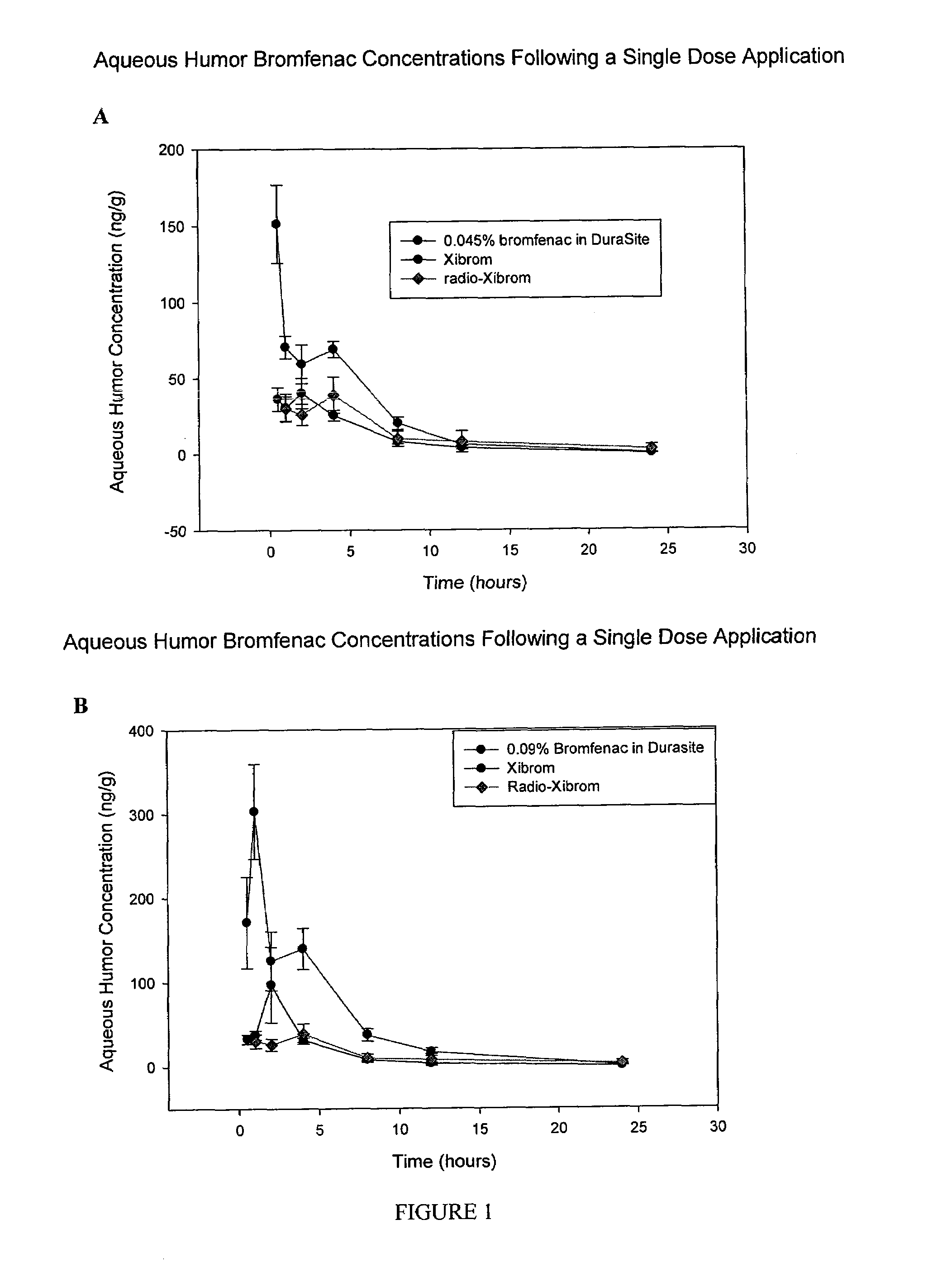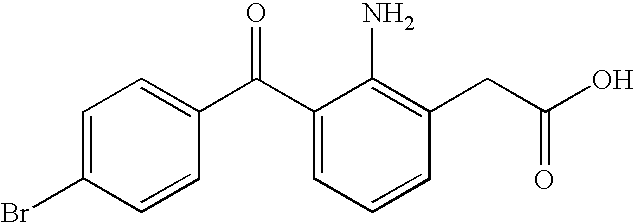[0017]As used herein the term “ophthalmic composition” refers to a composition intended for application to the eye or its related or surrounding tissues such as, for example,
eyelid. The term also includes compositions intended to therapeutically treat conditions of the eye itself or the tissues surrounding the eye and compositions administered via the ophthalmic
route to treat therapeutically a local condition other than that involving the eye. The ophthalmic composition can be applied topically or by other techniques, known to persons skilled in the art, such as injection to the eye or its related tissues. Examples of suitable topical administration to the eye include administration in eye drops and by spray formulations. A further suitable topical administration
route is by subconjunctival injection. The agents can also be provided to the eye periocularly or retro-orbitally. Although it is an
advantage of the invention that intracameral administration is not required, this and other routes of administration are not outside the scope of the invention.
[0018]As used herein the term “flowable mucoadhesive
polymer” refers to a carboxy-containing polymer, e.g., lightly
crosslinked polymers of
acrylic acid or the like, having an optimal
in vivo mucosal
absorption rate, safety, degradability and flowability for an
eye drop. The flowable
mucoadhesive polymers used in the present invention are
water insoluble, water-swellable,
biodegradable polymer carriers including lightly crosslinked carboxy-containing polymers such as polycarbophil (Noveon® AA-1, Lubizol Corp., Wickliffe, Ohio) or other Carbopol® polymers (Lubizol Corp., Wickliffe, Ohio). Suitable carboxy-containing polymers for use in the present invention and methods for making them are described in U.S. Pat. No. 5,192,535 to Davis et al. which is hereby incorporated in its entirety by reference. A suitable carboxy-containing polymer
system for use in the present invention is known by the tradename DuraSite® (InSite Vision Inc., Alameda, Calif.), containing polycarbophil, which is a sustained release topical ophthalmic
delivery system that releases
drug at a controlled rate. DuraSite® encompass lightly
crosslinked polymers that are prepared by suspension or
emulsion polymerizing at least about 90% by weight of a carboxyl-containing monoethylenically
unsaturated monomer such as
acrylic acid with from about 0.1% to about 5% by weight of a polyfunctional, or difunctional, crosslinking agent such as divinyl glycol (3,4-dihydroxy-1,5-hexadiene), having a particle size of not more than about 50 μm in
equivalent spherical diameter, when formulated with an ophthalmic medicament, e.g., bromfenac, into solutions or suspensions in
aqueous medium in which the amount of polymer ranges from about 0.5% to about 1.5% by weight, based on the total weight of the
aqueous suspension, the pH is from about 7.4 to about 8.5, and the
osmotic pressure (osmolality or
tonicity) is from about 10 mOsM to about 400 mOsM, provide new topical ophthalmic medicament delivery systems having suitably low viscosities which permit them to be easily administered to the eye in drop form, and hence be comfortably administrable in consistent, accurate dosages. The compositions of the invention containing DuraSite® will rapidly gel in the eye after coming into contact with the eye's tear fluid to a substantially greater
viscosity than that of the originally-introduced suspension or solution and thus remain in place for prolonged periods of time to provide sustained release of the ophthalmic medicament.
[0019]As used herein the term “retained in or carried with” or “retaining or carrying” embraces generally all ways that bromfenac can be associated with the flowable mucoadhesive polymer. For example, bromfenac can be in
aqueous solution dispersed throughout the polymer. A bromfenac concentration of up to about 0.09% will be in solution mixed with or dispersed throughout the flowable mucoadhesive polymer carrier. Bromfenac can also be in suspension with the polymer depending on its concentration. For example, when bromfenac is used in an amount more than about 0.36% by weight of the composition, some of the bromfenac can be in suspension with the polymer carrier while an amount of up to about 0.36% of bromfenac will still be in solution and mixed with the polymer carrier.
[0020]As used herein the term “
inflammation or inflammatory conditions of the eye” refers to an
ocular disease or any inflammatory condition of the eye and external tissues surrounding eye, e.g.,
eyelid, influenced by various exogenous or endogenous agents or events. Endogenous factors include, but are not limited to, inflammatory chemokines, cytokines, mediators, nuclear transcription factors, antigens, autogens or hormones that can cause acute or chronic
inflammation, pain, redness, swelling, wateriness and itchiness of the eye or its surrounding tissues. Exogenous agents or events include, but are not limited to, infection, injury,
radiation,
surgery or damage to the eye or its surrounding tissues, which initiate
biochemical reactions leading to an inflammation. An
ocular disease is one caused by
vascular leakage in the eye or by inflammation in the eye. Examples of conditions related to inflammation in the eye include, but are not limited to the following: surgical trauma; dry eye;
allergic conjunctivitis; viral conjunctivitis;
bacterial conjunctivitis;
blepharitis; anterior
uveitis; injury from a chemical;
radiation or
thermal burn; or penetration of a
foreign body,
signs and symptoms of eye problems (e.g., pain in or around the eye, redness especially accompanied by pain in the eye (with or without movement), extreme
light sensitivity, halos (
colored circles or halos around lights), bulging (protrusion) of the eye or swelling of eye tissues,
discharge, crusting or excessive tearing; eyelids stuck together, especially upon awakening, blood inside the front of the eye (on the
colored part) or white of the eye);
cataracts; pain and inflammation associated with wearing contact lenses; corneal conditions (e.g., conjunctival
tumor excision, conjunctivitis (“Pink Eye”),
cornea edema after cataract surgery, corneal clouding,
corneal transplantation,
corneal ulcer, dry eye syndrome, dystrophies, conditions associated with
excimer laser phototherapeutic keratectomy, herpes simplex
keratitis,
keratoconus, pterygium, recurrent
erosion syndrome);
eye movement disorders;
glaucoma; ocular
oncology, oculoplastics (e.g., cosmetic
surgery, enucleation,
eyelid and
orbit injuries, ectropion, entropion, graves'
disease, involuntary eyelid blinking); conditions associated with
refractive surgery; and
retinal conditions.
[0021]As used herein the term “sustained release
delivery system” or “sustained release composition” refers to a composition comprising a flowable mucoadhesive polymer—which is a carboxy-containing polymer such as polycarbophil and DuraSite®, as described in U.S. Pat. No. 5,192,535- which facilitates a sustained release of bromfenac. Such compositions may include other biologically active agents besides bromfenac. Typically, the sustained release compositions of the invention can contain from about 0.005% (w / w) to about 0.5% of bromfenac (
free acid). In an embodiment, the range of bromfenac loading is between about 0.01% (w / w) to about 0.2%. In another embodiment, the range of bromfenac loading is between about 0.045% (w / w) to about 0.09%. The sustained release delivery systems or compositions of this invention can be formed into many shapes such as a solution, a gel, a film, a pellet, a rod, a filament, a cylinder, a disc, a
wafer, nanoparticles or a
microparticle. A “
microparticle” as defined herein, comprises a blend polymer component having a
diameter of less than about one
millimeter and having bromfenac dispersed therein. A
microparticle can have a spherical, non-spherical or
irregular shape. Typically, the microparticle will be of a size suitable for injection. In one embodiment, the size range for microparticles is from about one to about 50 microns in
diameter.
[0022]As defined herein, a sustained release of a biologically
active agent is a release of the biologically
active agent (e.g., bromfenac) from a sustained release
delivery system or composition. The release occurs over a period which is longer than that period during which a therapeutically significant amount of the biologically
active agent would be available following direct administration of a solution of the biologically active agent. In one embodiment, a sustained release occurs over a period of greater than six to twelve hours such as about twenty-four hours or longer. A sustained release of biologically active agent can be a continuous or a discontinuous release, with relatively constant or varying rates of release. The continuity of release and level of release can be affected by the type of
polymer composition used (e.g.,
monomer ratios, molecular weight, and varying combinations of polymers), agent loading, and / or selection of excipients to produce the desired effect.
 Login to View More
Login to View More 

